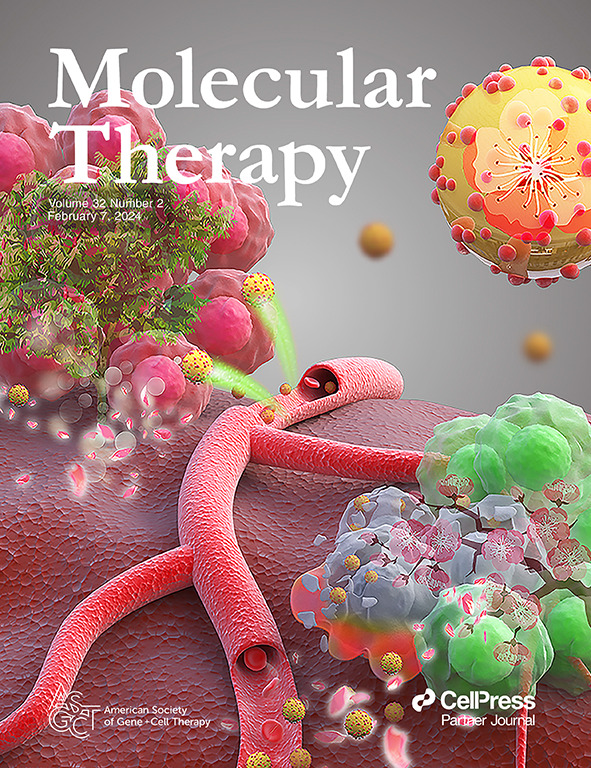aav介导的全体性基因治疗在一种新特征的猫粘脂病模型中的年龄敏感反应。
IF 12.1
1区 医学
Q1 BIOTECHNOLOGY & APPLIED MICROBIOLOGY
引用次数: 0
摘要
II型粘脂病(MLII)是由GNPTAB突变和溶酶体酶的甘露糖6-磷酸依赖性靶向缺失引起的溶酶体储存障碍。受影响的儿童表现为认知缺陷、骨骼发育不良和心肺疾病,通常在10岁之前死亡。自然发生的猫MLII模型是由GNPTAB的无义突变引起的;猫会出现溶酶体酶活性升高、生长迟缓、骨骼畸形、失明、心脏肥大和过早死亡。大多数lsd表现为中枢神经系统疾病,这是发病率和死亡率的主要原因。因此,我们评估了猫MLII的神经系统疾病。MLII猫活到大约5个月大,听力和感觉神经传导受损,脑积水,溶酶体相关膜蛋白1的表达增加。细胞因子和趋化因子的量化揭示了失调,阐明了潜在的病理机制和非侵入性生物标志物。然后我们评估了腺相关病毒(AAV)介导的基因治疗。用编码猫GNPTAB的AAV9对MLII猫进行治疗。高剂量AAV9-fGNPTAB干预在出生第一周是致命的;然而,延迟治疗至4周是可以容忍的。然而,最高剂量对与MLII相关的眼科、骨骼和心脏疾病的矫正效果最好。本文章由计算机程序翻译,如有差异,请以英文原文为准。
Age sensitive response of systemic AAV-mediated gene therapy in a newly characterized feline model of mucolipidosis II.
Mucolipidosis II (MLII) is a lysosomal storage disorder caused by mutations in GNPTAB and loss of mannose 6-phosphate-dependent targeting of lysosomal enzymes. Affected children exhibit cognitive deficits, skeletal dysplasia and cardio-pulmonary disease with death typically occurring before ten. A naturally occurring feline model of MLII results from a nonsense mutation in GNPTAB; cats develop elevated lysosomal enzyme activities, growth retardation, skeletal deformities, blindness, cardiomegaly, and die prematurely. Most LSDs exhibit central nervous system disease, which is a primary contributor to morbidity and mortality. Therefore, we evaluated nervous system disease in feline MLII. MLII cats lived to approximately 5 months of age, had impairments in hearing and sensory nerve conduction, hydrocephalus, and increased expression of lysosomal associated membrane protein 1. Quantification of cytokines and chemokines revealed dysregulation, elucidating potential pathomechanisms and non-invasive biomarkers. We then evaluated adeno-associated virus (AAV)-mediated gene therapy. MLII cats were treated with AAV9 encoding feline GNPTAB. High dose AAV9-fGNPTAB intervention in the first week of life was fatal; however, delaying treatment to 4 weeks was tolerated. Correction was not complete, however, the highest dose resulted in greatest correction of ophthalmic, skeletal, and cardiac disease associated with MLII.
求助全文
通过发布文献求助,成功后即可免费获取论文全文。
去求助
来源期刊

Molecular Therapy
医学-生物工程与应用微生物
CiteScore
19.20
自引率
3.20%
发文量
357
审稿时长
3 months
期刊介绍:
Molecular Therapy is the leading journal for research in gene transfer, vector development, stem cell manipulation, and therapeutic interventions. It covers a broad spectrum of topics including genetic and acquired disease correction, vaccine development, pre-clinical validation, safety/efficacy studies, and clinical trials. With a focus on advancing genetics, medicine, and biotechnology, Molecular Therapy publishes peer-reviewed research, reviews, and commentaries to showcase the latest advancements in the field. With an impressive impact factor of 12.4 in 2022, it continues to attract top-tier contributions.
 求助内容:
求助内容: 应助结果提醒方式:
应助结果提醒方式:


